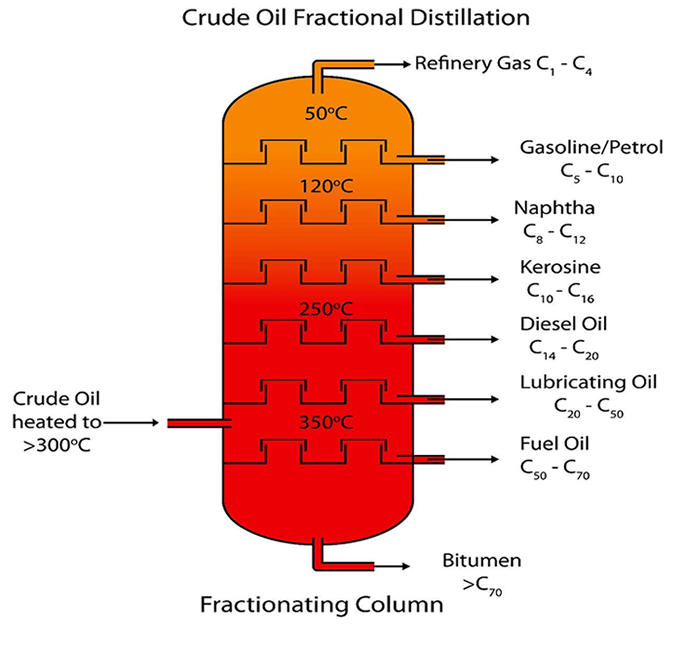Lubricating oils generally consist of two parts, base oil and additive. Base oil is the main component of lubricating oil, which determines the basic properties of lubricating oil. Additives can make up for and improve the performance of base oil, and give some new properties. It is an important part of lubricating oil.
Lubricating oil is mainly used to reduce the friction between the surface of moving parts. At the same time, it has the functions of cooling, sealing, anti-corrosion, anti-rust, insulation, power transmission and cleaning impurities. The raw material is mainly derived from a lubricating oil fraction and a residue fraction from a crude oil distillation unit. The most important properties of lubricating oils are viscosity, oxidation stability and lubricity, which are closely related to the composition of the lubricating oil fraction. Viscosity is an important quality indicator that reflects the fluidity of a lubricant. Different conditions of use have different viscosity requirements. Heavy-duty and low-speed machines use high-viscosity lubricants. Oxidation stability indicates the antioxidant capacity of the oil in the environment of use due to temperature, oxygen in the air, and metal catalysis. After the oil is oxidized, a fine carbonaceous substance mainly composed of asphaltenes is formed according to the use conditions, and is a viscous lacquer-like substance or a paint film, or a viscous aqueous substance, thereby reducing or losing the use property. Lubricity means the wear reduction performance of the lubricating oil. The concept of a lubricant additive is one or more compounds added to the lubricant to give the lubricant some new properties or to improve some of the properties already present in the lubricant. Additives are mainly divided into functional categories, such as antioxidant and metal deactivator, extreme pressure antiwear additive, friction modifier (also known as oiliness agent), detergent dispersant, foam inhibitor, antirust agent, antioxygen preservative, flow point improver, viscosity index enhancer, anti emulsion and so on. The additives sold in the market are generally composites of the above single additives, the difference being that the composition of the single additive is different and the ratio of several single additives inside the composite additive is different.
Lubricating oil plays an indispensable role in daily life, but there are also some common misunderstandings, which are shared here:
Misunderstanding 1: Lubricating oil can be added as much as possible.
The amount of lubricant should be controlled between the upper and lower scale lines of the dipstick. Because too much lubricating oil will break into the combustion chamber from the gap between the cylinder and the piston to form carbon deposits. These carbon deposits will increase the compression ratio of the engine and increase the tendency to produce knock; the red hot state of the carbon deposit in the cylinder is also likely to cause premature combustion. If it falls into the cylinder, it will aggravate the wear of the cylinder and the piston, and accelerate the pollution of the lubricating oil. Secondly, too much lubricating oil increases the agitation resistance of the crankshaft connecting rod, which increases fuel consumption.
Misunderstanding 2: When the lubricant turns black, it is time to change the oil.
This understanding is not comprehensive. For lubricating oils that do not have a clear dispersant, the blackening of the color is indeed a manifestation of the deterioration of the oil, but the lubricating oil used in modern automobiles is generally provided with a detergent decomposing agent. The detergent washes the film and black coke adhering to the piston and disperses them in the oil to reduce the formation of high-temperature deposits in the engine. Therefore, the color of the lubricating oil tends to turn black after a period of time, but the oil does not completely deteriorate at this time.
Misunderstanding 3: Lubricants can be often added without changing
Frequently checking that the lubricant is correct, but only adding and not replacing can only make up for the shortage of the oil, but can not fully compensate for the loss of performance of the lubricant. During the use of lubricating oil, the quality will gradually decrease due to pollution, oxidation, etc., and there will be some consumption, which will reduce the quantity.
Misunderstanding 4: The use of additives is very large
A truly high-quality lubricant is a finished product with a variety of engine protection features. The formula already contains a variety of additives, including anti-wear agents, and the lubricants are most focused on the balance of the formula to ensure the full performance of various properties. Adding other additives by yourself not only can not bring extra protection to the vehicle, but it is easy to react with the chemical substances in the oil, resulting in a decrease in the overall performance of the oil.

